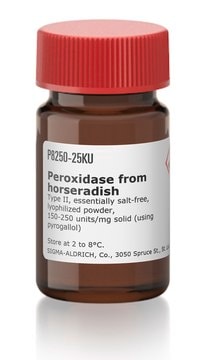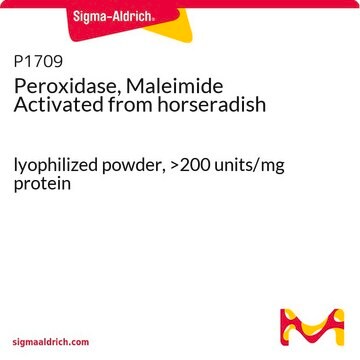10108090001
Roche
Peroxidase (POD)
grade I, from horseradish
Sinonimo/i:
POD, peroxidase
About This Item
Prodotti consigliati
Origine biologica
horseradish
Livello qualitativo
Forma fisica
lyophilized (salt-free)
Attività specifica
≥250 units/mg protein (At 25 °C with guaiacol and H2O2 as the substrates.)
250 U/mg
Confezionamento
pkg of 25,000 U
Produttore/marchio commerciale
Roche
pH ottimale
6.0-6.5
Condizioni di spedizione
wet ice
Temperatura di conservazione
2-8°C
Categorie correlate
Descrizione generale
Applicazioni
Azioni biochim/fisiol
Qualità
Purity number: approximately 3.0 (A403/A275)
Nota sulla preparazione
Working solution: PBS (phosphate buffered saline) or water (starting concentration 20 mg/ml).
Ricostituzione
Altre note
Avvertenze
Danger
Indicazioni di pericolo
Consigli di prudenza
Classi di pericolo
Resp. Sens. 1 - Skin Sens. 1
Codice della classe di stoccaggio
11 - Combustible Solids
Classe di pericolosità dell'acqua (WGK)
WGK 1
Punto d’infiammabilità (°F)
Not applicable
Punto d’infiammabilità (°C)
Not applicable
Certificati d'analisi (COA)
Cerca il Certificati d'analisi (COA) digitando il numero di lotto/batch corrispondente. I numeri di lotto o di batch sono stampati sull'etichetta dei prodotti dopo la parola ‘Lotto’ o ‘Batch’.
Possiedi già questo prodotto?
I documenti relativi ai prodotti acquistati recentemente sono disponibili nell’Archivio dei documenti.
I clienti hanno visto anche
Il team dei nostri ricercatori vanta grande esperienza in tutte le aree della ricerca quali Life Science, scienza dei materiali, sintesi chimica, cromatografia, discipline analitiche, ecc..
Contatta l'Assistenza Tecnica.












